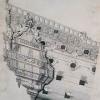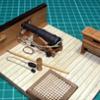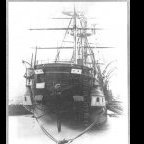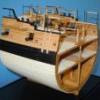MORE HANDBOOKS ARE ON THEIR WAY! We will let you know when they get here.
×
-
Posts
936 -
Joined
-
Last visited
Reputation Activity
-
 shipmodel got a reaction from EricWilliamMarshall in Queen Anne's Revenge 1710 by shipmodel - FINISHED - 1/36 scale
shipmodel got a reaction from EricWilliamMarshall in Queen Anne's Revenge 1710 by shipmodel - FINISHED - 1/36 scale
Hello to all -
Those of you who followed my building of the Swan 42 racing yacht may experience some temporal whiplash as the Wayback Machine moves the shipyard some 300 years into the past. Even though the scale will be about the same, the materials, methods, and style will have little or nothing in common with the last project. We leave the clean lines and millimeter accuracy of a rich man's toy for the rough outlines and incomplete draughts of a pre-Colonial pirate ship.
Queen Anne's Revenge was the flagship of the notorious pirate Edward Thatch (incorrectly called Teach), known as Blackbeard. In barely more than a year and a half, from the summer of 1717 to November 22, 1818, he and two other pirate leaders put together a large fleet that took numerous merchant ships, looting them and holding any worthwhile captives for ransom while taking any willing sailors into his piratical crew. He was hardly the most notorious or bloodthirsty pirate, but he captured the popular imagination with his large fierce black beard and his habit of placing lit rope matches for his weapons into his hair during a battle.
The origins of the ship herself are not definitively known. It is thought that she was built in about 1710 as a small frigate of about 300 tons known as La Concorde, with her first cruise as a French privateer during Queen Anne's War in 1711. When the war ended in 1713 with the Treaty of Utrecht her owners sent her into the slave trade. She made two profitable cruises between 1713 and 1717, taking slaves from West Africa to the French colonies in the Carribean and capturing prizes on the return leg back to France. On November 28, 1717, during her third slaving cruise, she fell afoul of Blackbeard with two armed sloops. Her crew was sick and many of the cannon had been removed to make more room for slaves so she was captured easily. Below is a drawing of a similar light frigate from the early 1700s.
After renaming her Queen Anne's Revenge and adding significantly more cannon, she became Blackbeard's flagship and was used to capture numerous ships and even to blockade the port of Charleston for a week. Turning north from there in company with several smaller pirate ships on June 10, 1718 they tried to enter a shallow anchorage known as Topsail Inlet (or Old Topsail Inlet), now called Beaufort Inlet in North Carolina. Although several other ships entered safely, the larger Queen Anne's Revenge grounded on the sand bar at the entrance, as did another ship that came to her aid. After removing the valuables she was abandoned and left to the cruel mercies of the sea. Blackbeard himself lasted barely another six months until his death in November of 1718 during a battle with the Royal Navy.
The ship was rediscovered in 1996 and is now being excavated underwater in project managed by the North Carolina Department of Cultural Affairs and the North Carolina Maritime Museum, part of East Carolina University. Numerous artifacts, including several cannon, coins, navigational equipment, and hundreds of everyday items have been recovered and are being conserved. You can see photographs of the artifacts, view interactive maps of the ship's history and the wreck site, and read the archaeologists' and researchers' detailed reports if you go to the Queen Anne's Revenge website at http://www.qaronline.org/Home.aspx It is a little gem of a site and well worth looking into.
I have been asked to build two display models of the QAR for the Maritime Museum. They will be at the large scale of 1:36, yielding a model of some 48" LOA from the tip of the jib boom to the ensign staff at the stern. It will rise some 44" from the keel to the main truck with a main yard of some 22" with stunsail booms rigged but not extended. The hull is to be solid below the gun deck but open and fully detailed above. She is to have a full suit of sails with all sail handling lines, although several will be furled so the deck can be more easily viewed.
There are no plans or illustrations of the ship, so her apearance is a bit conjectural. As a basis for the model I have been given two sets of plans. The first is a simple, one-page rendering of the lines and profile of a similar small French frigate which was captured by HMS Advice and which is known therefore as Advice Prize.
I am also working from a set of drawings done by Jean Budriot of yet another light French frigate of the period known as Le Mercure. He has written a monograph that is illustrated with numerous detailed drawings of all of the bits and pieces of the ship including several profiles, cross-sections and longitudinal sections, and sail and rigging plans. However, as is his custom, there is no station lines plan from which to derive the hull shape.
These two sets of plans have to be reconciled, not only with each other, but with the known historic facts. For example, it was reported in contemporary accounts and court-martial testimony that the Queen Anne's Revenge had 20 large cannon on board when she went down. Le Mercure is pierced for 10 guns on each side, but the Advice Prize has only 9. The Mercure drawings have the channels for the fore and main shrouds set below the gunports, while the Advice Prize has them above. Le Mercure is shown with a square, open beakhead bulkhead, while the plans for the Advice Prize shows a closed in forecastle. At the stern Le Mercure has a large quarter gallery, rather than the small quarter badge of the Advice Prize. But that quarter badge is set very high, with an indication that the Advice Prize had a poop deck above the quarterdeck. These and many other details, large and small, will have to be reconciled as construction continues.
To begin with, a tenth gunport was added to the Advice Prize and their spacing was adjusted accordingly. The quarter badge was lowered and it is this resulting profile that will be used to build the models.
On this plan you can see a horizontal red line. This is my line of demarcation between the solid hull below and the open gundeck above. It is set at the level of the gundeck for the forward four ports. A tapered piece will be added at the rear half of the ship to account for the sheer rise of the gundeck towards the stern. But this line is also used as my registration plane for setting up the templates for the hull shape at the various stations shown on the plans.
As I was working out the hull construction the first of what will surely be many problems arose. In the scale that is required, the maximum breadth of the model works out to just over 9 inches and the station lines work out to, mostly, 3 inches separation. To work from the centerline I would need wood of at least 4.5 inches wide and 3 inches thick. However, wood of that size is not easily or inexpensively acquired. Instead, I found basswood planks 4 inches wide and up to 2 inches thick. I decided therefore to piece together the hull.
As you can see in the wood blocking plan below, I started with a vertical central piece 3/8" thick to match the width of the keel. This was sandwiched on each side by a vertical lift 1/2 inch thick, then by the side pieces whch would be cut to the profiles of the appropriate station lines from the plans.
As usual with vertical station line lifts, they were cut to the profile of the appropriate station line. For each three inch station segment a two inch lift and a one inch lift were used. I also decided that the hull should be partially hollow, not only to reduce weight, but to give the stresses somewhere to go other than outward when the wood swelled with changing humidity. My solution was to take each lift and cut out the center, leaving a crescent of wood about 1 inch thick. Construction began with the gunport deck piece cut to shape and the three vertical central pieces glued to it using carpenters' squares for alignment. Then the station line lift crescents were glued in place and secured with dowels. Here you can see the first three segments glued and pinned, with the fourth made ready for installation.
This was continued from the center out to the bow and stern, with the final lifts left solid and clamped to the growing hull block. The completed hull block was left to dry for a week before the bamboo dowels were trimmed off.
Now the carving and shaping had to begin to reduce the stepped shape of the lifts. The model is so large that the usual woodworking tools were inadequate in any reasonable time frame. I therefore purchased an angle grinder and set it up with coarse 50 grit sanding discs. This was followed by a random orbit sander, also with coarse grit paper.
As you can imagine, this makes a hellish racket and leaves a hellish mess, Eye, ear and respiration protection are a must, and if you are not going to do all of it outside, you need three other things - an empty room in the basement; a big shop vacuum; and most importantly, an understanding wife. I am glad to say that I have the first two and am blessed with the third.
In this photo you can see how far the shaping has progressed. From here there still has to be a lot of hand work that is checked and rechecked as usual with station line templates. The next segment will take us through that process.
Be well
Dan
-
 shipmodel got a reaction from EricWilliamMarshall in Queen Anne's Revenge 1710 by shipmodel - FINISHED - 1/36 scale
shipmodel got a reaction from EricWilliamMarshall in Queen Anne's Revenge 1710 by shipmodel - FINISHED - 1/36 scale
Hi all -
Yes, an interesting project that is open to some speculation. Although there is no definitive information on the ship's appearance, we can reason backward from what is known.
A researcher on the project has combed through the French archives and in his 159 page report he convincingly demonstrates that she was built as La Concorde for a private commercial firm, rather than for the French navy. She is described as being one of the light frigates of 250 to 300 tons, which fits well with other such ships being built for the navy, so her design was probably quite similar. Budriot, in his major work, "The History of the French Frigate, 1650-1850" has a short chapter on these light frigates with illustrations of several of the naval frigates as well as lines drawings and artistic illustrations such as the one that I included. There is even a lengthy written description of a "Light frigate armed with 20 6-pounders" which is exactly what the Queen Anne's Revenge was. I am still working through the dense prose to glean bits of useful information.
However, she was not built for the navy, but for a private firm. As such, she would not have had the elaborate carvings, paint and decorations that a national warship would have carried and which Budriot puts on Le Mercure.. Even if there were originally some touches of color, by the time she finished a privateering cruise and two slaving trips some seven years later I do not believe that any would have remained.
We are on surer ground with the rig. Masts and spars were pretty well standardized by 1710 for the size of the ship. Budriot provides a detailed drawing of all of the sticks and fittings in the Mercure drawings, which will be checked against Lees, Petrejus and other writers. But that is for later - much later.
Till then, be well.
Dan
-
 shipmodel got a reaction from EricWilliamMarshall in La Belle Poule 1765 by mtaylor - Scale 1:64 - POB - French Frigate from ANCRE plans
shipmodel got a reaction from EricWilliamMarshall in La Belle Poule 1765 by mtaylor - Scale 1:64 - POB - French Frigate from ANCRE plans
Hi Mark =
Your model is coming along very nicely.
Welcome now to the wonderful world of carving. It really is wonderful, despite a pretty steep learning curve.
As others have said, the more you do, the better you will get at it.
Having worked my way up the curve, I have some thoughts and a tip that works for me.
First, there are two basic methods for miniature carving - chip, or knife carving and rotary carving.
In the first, the unwanted material is removed with a blade or chisel. In the other, by burrs and bitts in a Dremel or similar.
To see an excellent use of the first method, check out Hubac's Historian's build of the Soleil Royale.
Although he is carving styrene, the principles are the same.
To see what rotary carving is about, look at my build of the Queen Anne's Revenge [just click on it below in my profile]
The carving of the figurehead starts on page 2
I do 95% of my carving with rotary tools and only the last little bits with a knife to get a crisp edge where I need it.
It is just a process of removing everything that does not look like the piece that you want.
As for the tip -
When you begin carving the flags and lances, mount the carving blank to a larger disc of scrap wood.
Use cyano or rubber cement, or another solvent based adhesive.
The round shape will let you easily turn it so you can attack the work from all angles.
The backing will support the thin shafts of the lances and other delicate details.
When you are done soak the entire piece in acetone or denatured alcohol until the carving comes free without force.
I hope that this helps a bit.
Keep up the excellent work.
Dan
-
 shipmodel got a reaction from FrankWouts in HMS Winchelsea - FINISHED - 1764 - by Chuck (1/4" scale)
shipmodel got a reaction from FrankWouts in HMS Winchelsea - FINISHED - 1764 - by Chuck (1/4" scale)
Hi Chuck -
Beautiful craftsmanship, as always. All the joints are so clean and tight, which is really impressive.
Though I do not plan to build a kit, I have read pretty much every instruction manual, article and book, and wrote a few with Jim Roberts.
I have to say that your explanations and instructions are up there with the best. They are as clean and tight as your woodwork.
Following along in my head I take it a sentence or two at a time and I can actually see the model rising from the building board.
Every one building the model is extremely lucky to have you take them through a master class in the arts of the shipwright.
Two small suggestions, if I may - -
First, it might be a bit easier for the modelers if you gave them the knee of the cathead along with cathead. The slant of its top will establish the angle of the cathead relative to the hull. This then determines the way the bottom of the notch rises from inboard to outboard.
Second, you suggest a really sharp chisel for the cuts. I think many of your followers would appreciate a quick lesson in sharpening chisels. I don't know, myself, I just pull out a fresh hobby blade. It is a skill that I should add to my toolbox.
Keep on with the good work.
Stay safe and well
Dan
-
 shipmodel got a reaction from EricWilliamMarshall in La Belle Poule 1765 by mtaylor - Scale 1:64 - POB - French Frigate from ANCRE plans
shipmodel got a reaction from EricWilliamMarshall in La Belle Poule 1765 by mtaylor - Scale 1:64 - POB - French Frigate from ANCRE plans
Hi Mark -
So glad you are recovering from the aftereffects of your stroke. I know that it will take time, but mental exercises like model building can make the process as speedy and complete as possible. You have best wishes from me and, I am sure, the entire ModelShipWorld community.
When you have a moment, I would love to see your helicopter.
Be well
Dan
-
 shipmodel reacted to Hubac's Historian in Soleil Royal by Hubac's Historian - Heller - An Extensive Modification and Partial Scratch-Build
shipmodel reacted to Hubac's Historian in Soleil Royal by Hubac's Historian - Heller - An Extensive Modification and Partial Scratch-Build
From a life standpoint, my sister and I have made tremendous strides in sorting out our father’s affairs, and our current biggest hurdle is getting approval from his long-term care insurer for assisted living. Steadily, we are getting there, and I appreciate those who have asked, just as I appreciate everyone who comes to visit me here.
I have managed to sneak-in a few hours, here and there, and I have completed all of the port side buttressing knees of the channels, and I got everything nicely re-painted and pretty. In general, lowering the channels pretty dramatically changes the whole aspect of the model, and the difference is pleasing to me:
The mizzen channel knees were challenging to cope over mouldings and around the fleurs, but I am happy to have lowered them to here, where there is less interference with the frieze:
I am using this portrait of the DR, circa 1680, as justification for this placement:
I continue to comb through the archives, but I have yet to find anything vividly descriptive about the ship’s pre-refit external appearance. Despite the beautifully florid cursive, I’ve come to realize the hard truth that the letter writers and record keepers of 17th C. France were basically clerks. Mostly their correspondence has to do with SR’s comings and goings; armaments and dis-armements; payments made/owed to painters and sculptors; cost estimates relating to her refit, etc. It is all fascinating, and it will all get its due mention in my book, but it does not help me paint the picture of the ship.
Where are the artists sharing their wonderfully descriptive observations, when you need them?!
What I’m hoping to find is something along the lines of this:
”The morning fires shone brightly upon the gilded ornaments of Soleil Royal and her heights rose up and became one with the azure sky. The warrior of the Americas clung resolutely to the port side, while that of Africa peered off in the middle-distance - daring his lesser adversaries to emerge from the morning mist. Presiding above, with shimmering rays of gold and silver gilt bursting past his golden chariot is the Sun King, himself…”
And, so forth. It must be out there, somewhere, right?
Anyway, I can now get busy with fitting and prepping the starboard upper bulwark for paint. I can also go ahead and design my stove - that will make a nice little side project. Before long, I can design and make the next tier of stern lights, which will enable me to finish off the wrapping stern walk.
As always, thank you for your likes, comments and for looking-in. More to come!
-
 shipmodel got a reaction from Hubac's Historian in Speedwell 1752 by dvm27 (Greg Herbert) - FINISHED - Ketch Rigged Sloop
shipmodel got a reaction from Hubac's Historian in Speedwell 1752 by dvm27 (Greg Herbert) - FINISHED - Ketch Rigged Sloop
Good point. I had not measured the drawing.
I think your decision is a good one.
Stay safe and well
Dan
-
 shipmodel got a reaction from BANYAN in Speedwell 1752 by dvm27 (Greg Herbert) - FINISHED - Ketch Rigged Sloop
shipmodel got a reaction from BANYAN in Speedwell 1752 by dvm27 (Greg Herbert) - FINISHED - Ketch Rigged Sloop
Good point. I had not measured the drawing.
I think your decision is a good one.
Stay safe and well
Dan
-
 shipmodel got a reaction from mtaylor in Speedwell 1752 by dvm27 (Greg Herbert) - FINISHED - Ketch Rigged Sloop
shipmodel got a reaction from mtaylor in Speedwell 1752 by dvm27 (Greg Herbert) - FINISHED - Ketch Rigged Sloop
Good point. I had not measured the drawing.
I think your decision is a good one.
Stay safe and well
Dan
-
 shipmodel got a reaction from druxey in Speedwell 1752 by dvm27 (Greg Herbert) - FINISHED - Ketch Rigged Sloop
shipmodel got a reaction from druxey in Speedwell 1752 by dvm27 (Greg Herbert) - FINISHED - Ketch Rigged Sloop
Good point. I had not measured the drawing.
I think your decision is a good one.
Stay safe and well
Dan
-
 shipmodel got a reaction from Justin P. in Speedwell 1752 by dvm27 (Greg Herbert) - FINISHED - Ketch Rigged Sloop
shipmodel got a reaction from Justin P. in Speedwell 1752 by dvm27 (Greg Herbert) - FINISHED - Ketch Rigged Sloop
Hi Greg -
The new tops look good, as do all your masts and spars. They should compliment your hull and fittings very nicely.
As for the tops as drawn, I do not know of a contemporary model with such tops, but Captain Bligh's notes on the conversion of the Bethia to the HMS Bounty indicates that he had her fitted with 'gratten' tops, which I took to mean 'gratings'. I suppose that this was to readily shed water in the rainy South Pacific where he was headed. I have seen some modern models with such tops, and some look quite nice.
As the man said, "You pays yer money and you makes yer choice. . ."
Stay safe and well.
Dan
-
 shipmodel reacted to KeithAug in Germania Nova 1911 by KeithAug - FINISHED - Scale 1:36 - replica of schooner Germania 1908
shipmodel reacted to KeithAug in Germania Nova 1911 by KeithAug - FINISHED - Scale 1:36 - replica of schooner Germania 1908
Thank you Druxey / Michael. Also thanks to everyone for the likes.
I have been bitting around recently, Doing some of the mini jobs I missed out on the journey so far.
On the bulwarks 12 belaying pins are mounted, I toyed with the ideal of ignoring them but in the end I couldn't.
They are not terribly obvious and I guess most casual observers will miss them.
I had also missed a number of eyebolts on the jib mountings (annoying to make when setting up to do just a few).
I then moved on to stepping the masts - always a bit tricky to get the verticality and rake spot on.
Before installing the deck I had glued an extension to the keel to create a "tenon" to accept the mast foot. I had intended slotting the bottom of the mast but in the end went for a more sophisticated solution.
I turned a piece of dowel to fit the hole in the deck and into the end of this machined an oversized slot to fit over the tenon. I drilled an axial hole through the dowel and into this fixed a .312" brass rod of some 15 inch long. I then levelled the hull and set up the laser level to get the vertical. I then shimmed the slot with offcuts until I got the athwartship verticality correct. This achieved I marked the rake on the workshop wall and sighted against this line to set the rake angle. Adjusting the rake was simple as the slot was able to slide on the tenon. I applied wood glue to the slot and this gave me plenty of time to tune the rake angle.
The whole exercise was then repeated for the second mast.
-
 shipmodel got a reaction from Justin P. in Speedwell 1752 by dvm27 (Greg Herbert) - FINISHED - Ketch Rigged Sloop
shipmodel got a reaction from Justin P. in Speedwell 1752 by dvm27 (Greg Herbert) - FINISHED - Ketch Rigged Sloop
Good point. I had not measured the drawing.
I think your decision is a good one.
Stay safe and well
Dan
-
 shipmodel reacted to KeithAug in Germania Nova 1911 by KeithAug - FINISHED - Scale 1:36 - replica of schooner Germania 1908
shipmodel reacted to KeithAug in Germania Nova 1911 by KeithAug - FINISHED - Scale 1:36 - replica of schooner Germania 1908
A quick update. I solved the "U" bracket attachment problem with some small split pins that i had in my bits box.
They are made from .040" x .020" rectangular strip.
I inserted the "U" bracket into the eye of the pin and then filed off the corners of the legs so they would fit in the .040" bore of the turnbuckle. I glued the legs into the bore and it is now much stronger.
My wife finished the netting some months ago, now i just need to attach it. But not until the model is complete enough to move out of the workshop.
-
 shipmodel got a reaction from Hubac's Historian in Speedwell 1752 by dvm27 (Greg Herbert) - FINISHED - Ketch Rigged Sloop
shipmodel got a reaction from Hubac's Historian in Speedwell 1752 by dvm27 (Greg Herbert) - FINISHED - Ketch Rigged Sloop
Hi Greg -
The new tops look good, as do all your masts and spars. They should compliment your hull and fittings very nicely.
As for the tops as drawn, I do not know of a contemporary model with such tops, but Captain Bligh's notes on the conversion of the Bethia to the HMS Bounty indicates that he had her fitted with 'gratten' tops, which I took to mean 'gratings'. I suppose that this was to readily shed water in the rainy South Pacific where he was headed. I have seen some modern models with such tops, and some look quite nice.
As the man said, "You pays yer money and you makes yer choice. . ."
Stay safe and well.
Dan
-
 shipmodel got a reaction from druxey in Speedwell 1752 by dvm27 (Greg Herbert) - FINISHED - Ketch Rigged Sloop
shipmodel got a reaction from druxey in Speedwell 1752 by dvm27 (Greg Herbert) - FINISHED - Ketch Rigged Sloop
Hi Greg -
The new tops look good, as do all your masts and spars. They should compliment your hull and fittings very nicely.
As for the tops as drawn, I do not know of a contemporary model with such tops, but Captain Bligh's notes on the conversion of the Bethia to the HMS Bounty indicates that he had her fitted with 'gratten' tops, which I took to mean 'gratings'. I suppose that this was to readily shed water in the rainy South Pacific where he was headed. I have seen some modern models with such tops, and some look quite nice.
As the man said, "You pays yer money and you makes yer choice. . ."
Stay safe and well.
Dan
-
 shipmodel got a reaction from FriedClams in Speedwell 1752 by dvm27 (Greg Herbert) - FINISHED - Ketch Rigged Sloop
shipmodel got a reaction from FriedClams in Speedwell 1752 by dvm27 (Greg Herbert) - FINISHED - Ketch Rigged Sloop
Hi Greg -
The new tops look good, as do all your masts and spars. They should compliment your hull and fittings very nicely.
As for the tops as drawn, I do not know of a contemporary model with such tops, but Captain Bligh's notes on the conversion of the Bethia to the HMS Bounty indicates that he had her fitted with 'gratten' tops, which I took to mean 'gratings'. I suppose that this was to readily shed water in the rainy South Pacific where he was headed. I have seen some modern models with such tops, and some look quite nice.
As the man said, "You pays yer money and you makes yer choice. . ."
Stay safe and well.
Dan
-
 shipmodel reacted to archjofo in La Créole 1827 by archjofo - Scale 1/48 - French corvette
shipmodel reacted to archjofo in La Créole 1827 by archjofo - Scale 1/48 - French corvette
Garnet tackle - Palan d'etai
The garnet tackle were generally used for loading goods, cannons and for lowering and hoisting boats.
With regard to the execution of the stage tack, there are differences between the graphic representation of J. Boudriot in the monograph and the original model in the Paris Museum compared to the model of La Créole.
Source: Monograph La Creole by J. Boudriot pp. 125 and 126
Source: Monograph La Creole by J. Boudriot p. 101, photo detail of the original model
The execution of the garnet tackle documented in the Atlas du Génie maritime corresponds to the representation on the Paris model. Accordingly, I also do this on my La Créole model.
Source: Atlas du Génie maritime, annexe no.1, pl. 50
I was able to identify another garnet tackle on the photo of the original model. I will also represent this accordingly on my model.
I started the preparations for the appropriate arrangements of these rigging details with the production of the double and single blocks. A total of 6 double and 4 single blocks are to be produced. I determined the block size by scaling the drawings from the atlas in comparison with the block list from the monograph (dependency on the rope diameter), which ultimately fitted pretty well. Thus, the double blocks have a length of around 6.8 mm and the single blocks have a length of around 5.2 mm. The blocks were made in the manner that has meanwhile been tried and tested for me.
In this context I would like to emphasize that, from my point of view, it makes no sense to prepare the blocks in their entirety in advance. That would be several hundred blocks for this corvette. In the meantime I have laboriously learned that all these blocks have the most varied of sizes and shapes, depending on the purpose. There are also many differences in terms of their fittings and fastening. That's why I manufacture the blocks individually based on the respective detail section. Due to the complexity of rigging, any other approach does not seem expedient to me, unless one simplifies and differentiates less, which of course is at the expense of the level of detail. Ultimately, everyone has to decide for themselves.
As can be seen on the following drawing from the Atlas du Génie maritime, the French used heavy garnet tackle blocks with so-called swivel hooks (croc à émerillon).
Source: Atlas du Génie maritime, annexe no.1, pl. 2
Below is a picture collage for making the swivel hooks.
The majority of the required blocks, thimbles and hooks for the arrangements of the garnet tackle were made as far as can be seen in the next picture.
The manufactured brass parts are of course burnished to give them an iron-like appearance.
The next step is to make the garnet tackle. For this I still have to make the ropes in the appropriate strengths and serve. The necessary block strops must also be made.
Sequel follows …
-
 shipmodel reacted to Chuck in HMS Winchelsea - FINISHED - 1764 - by Chuck (1/4" scale)
shipmodel reacted to Chuck in HMS Winchelsea - FINISHED - 1764 - by Chuck (1/4" scale)
NO CHAR FOR YOU!!!!
Seriously though....knowing that some of you are now referring to me as the "Laser char nazi". There is a very valid reason. But its not all bad. There are times when removing the char isnt as necessary. BUT...I cant understand why it is left on items to remain bright...or painted red which shows. More on this later. LOL
Time for the Fcastle rail and timberheads.
There are twelve timberheads per side. Thats quite a few. And then let us not forget the many along the qdeck. These have been laser cut for you and yes there is a lot of char. Now I know that some of you will start to see these wonderful details being added which make the whole project special. And the more details like this the easier it is to lose your will to slow it down and you you start cutting corners. Because lets face it, getting these details on the model makes a huge difference and you want to see them on the model as quickly as possible. I suffer the same affliction, trust me.
BUT...lucky for us, we do not have to go crazy here removing the char from these timberheads which are quite small, with lots of inside corners for the char to hide. You will still need to give them a good cleaning to smooth out the surface for painting. I use sanding sticks and 420 grit sandpaper. The surface must be prepared but dont try and remove it all. You will distort the shape and also make the timberheads too small to fit snug in each hole of the rail. You can see how clean I made those timberheads. They are still pretty clean with just a light swipe of the sandpaper.
So you will save some time here which is good news because....
Because, I strongly urge you not to cut corners on the next step. You should certainly take the time to shape the timberheads on all four sides. Many of you will be tempted to just use them as is. That might be quick…but it would be a mistake.
The reason why this is so important is because they will appear much too heavy otherwise. Too many kits have ridiculously heavy and thick timberheads. It looks too kit-like. By chamfering all four sides at the top of the timberheads they will appear slimmed down and in scale. In addition, the angled front and back sides… You will need to slice down towards a "stop cut" to create the proper shape. See the photo above. This will make a huuuuge difference. So yes its ok to cut corners on the char here. But please do shape each timberhead carefully.
I also sanded the rail itself smooth and softened the four corners along its length. As I finished each
timberhead, I slid them from the bottom into position along the rail. I have created a small "stop" ledge on one side of each timberhead. If you didnt over sand them and remove this detail, it will keep the rail level and The rookie at the same height across all of the timberheads. Hope that makes sense. In addition, this “stop ledge” detail should always face forward when you slide the timberheads onto the rail. This is important.
When all the timberheads are cleaned and shaped, test the rail in position. The laser cut tenons on the bottom of each timberhead are not as wide as the holes in the caprail. So you should have wiggle room to adjust the timberheads and rail. Dont glue the timberheads into the rail yet. And dont glue the rail onto the model. While test-fitting in position, you need to add the fancy end piece. See below. Just glue it onto the end of the rail and let dry.
When dry, remove the entire rail from the model. Remove all the timberheads from the rail. I numbered the timberheads but that probably isnt necessary. Then do your best to fill the seam between that fancy end piece and sand it so you can not see any trace of the seam before painting the rail black.
Here is a picture of the forward end being tested below. Everything fits great. Nothing is glued together yet. Once that seam is acceptable to me, I will paint all of the timberheads black individually and also the rail. Then I will reassemble it for the last time and glue it on the model. This will take some considerable time....then I have to do it all over again on the starboard side.
Any questions???
-
 shipmodel got a reaction from mtaylor in Speedwell 1752 by dvm27 (Greg Herbert) - FINISHED - Ketch Rigged Sloop
shipmodel got a reaction from mtaylor in Speedwell 1752 by dvm27 (Greg Herbert) - FINISHED - Ketch Rigged Sloop
Hi Greg -
The new tops look good, as do all your masts and spars. They should compliment your hull and fittings very nicely.
As for the tops as drawn, I do not know of a contemporary model with such tops, but Captain Bligh's notes on the conversion of the Bethia to the HMS Bounty indicates that he had her fitted with 'gratten' tops, which I took to mean 'gratings'. I suppose that this was to readily shed water in the rainy South Pacific where he was headed. I have seen some modern models with such tops, and some look quite nice.
As the man said, "You pays yer money and you makes yer choice. . ."
Stay safe and well.
Dan
-
 shipmodel got a reaction from Jack12477 in Speedwell 1752 by dvm27 (Greg Herbert) - FINISHED - Ketch Rigged Sloop
shipmodel got a reaction from Jack12477 in Speedwell 1752 by dvm27 (Greg Herbert) - FINISHED - Ketch Rigged Sloop
Hi Greg -
The new tops look good, as do all your masts and spars. They should compliment your hull and fittings very nicely.
As for the tops as drawn, I do not know of a contemporary model with such tops, but Captain Bligh's notes on the conversion of the Bethia to the HMS Bounty indicates that he had her fitted with 'gratten' tops, which I took to mean 'gratings'. I suppose that this was to readily shed water in the rainy South Pacific where he was headed. I have seen some modern models with such tops, and some look quite nice.
As the man said, "You pays yer money and you makes yer choice. . ."
Stay safe and well.
Dan
-
 shipmodel got a reaction from Keith Black in Speedwell 1752 by dvm27 (Greg Herbert) - FINISHED - Ketch Rigged Sloop
shipmodel got a reaction from Keith Black in Speedwell 1752 by dvm27 (Greg Herbert) - FINISHED - Ketch Rigged Sloop
Hi Greg -
The new tops look good, as do all your masts and spars. They should compliment your hull and fittings very nicely.
As for the tops as drawn, I do not know of a contemporary model with such tops, but Captain Bligh's notes on the conversion of the Bethia to the HMS Bounty indicates that he had her fitted with 'gratten' tops, which I took to mean 'gratings'. I suppose that this was to readily shed water in the rainy South Pacific where he was headed. I have seen some modern models with such tops, and some look quite nice.
As the man said, "You pays yer money and you makes yer choice. . ."
Stay safe and well.
Dan
-
 shipmodel got a reaction from dvm27 in Speedwell 1752 by dvm27 (Greg Herbert) - FINISHED - Ketch Rigged Sloop
shipmodel got a reaction from dvm27 in Speedwell 1752 by dvm27 (Greg Herbert) - FINISHED - Ketch Rigged Sloop
Hi Greg -
The new tops look good, as do all your masts and spars. They should compliment your hull and fittings very nicely.
As for the tops as drawn, I do not know of a contemporary model with such tops, but Captain Bligh's notes on the conversion of the Bethia to the HMS Bounty indicates that he had her fitted with 'gratten' tops, which I took to mean 'gratings'. I suppose that this was to readily shed water in the rainy South Pacific where he was headed. I have seen some modern models with such tops, and some look quite nice.
As the man said, "You pays yer money and you makes yer choice. . ."
Stay safe and well.
Dan
-
 shipmodel got a reaction from bdgiantman2 in HMS Winchelsea - FINISHED - 1764 - by Chuck (1/4" scale)
shipmodel got a reaction from bdgiantman2 in HMS Winchelsea - FINISHED - 1764 - by Chuck (1/4" scale)
Hi Chuck -
Beautiful craftsmanship, as always. All the joints are so clean and tight, which is really impressive.
Though I do not plan to build a kit, I have read pretty much every instruction manual, article and book, and wrote a few with Jim Roberts.
I have to say that your explanations and instructions are up there with the best. They are as clean and tight as your woodwork.
Following along in my head I take it a sentence or two at a time and I can actually see the model rising from the building board.
Every one building the model is extremely lucky to have you take them through a master class in the arts of the shipwright.
Two small suggestions, if I may - -
First, it might be a bit easier for the modelers if you gave them the knee of the cathead along with cathead. The slant of its top will establish the angle of the cathead relative to the hull. This then determines the way the bottom of the notch rises from inboard to outboard.
Second, you suggest a really sharp chisel for the cuts. I think many of your followers would appreciate a quick lesson in sharpening chisels. I don't know, myself, I just pull out a fresh hobby blade. It is a skill that I should add to my toolbox.
Keep on with the good work.
Stay safe and well
Dan
-
 shipmodel got a reaction from BobG in HMS Winchelsea - FINISHED - 1764 - by Chuck (1/4" scale)
shipmodel got a reaction from BobG in HMS Winchelsea - FINISHED - 1764 - by Chuck (1/4" scale)
Hi Chuck -
Beautiful craftsmanship, as always. All the joints are so clean and tight, which is really impressive.
Though I do not plan to build a kit, I have read pretty much every instruction manual, article and book, and wrote a few with Jim Roberts.
I have to say that your explanations and instructions are up there with the best. They are as clean and tight as your woodwork.
Following along in my head I take it a sentence or two at a time and I can actually see the model rising from the building board.
Every one building the model is extremely lucky to have you take them through a master class in the arts of the shipwright.
Two small suggestions, if I may - -
First, it might be a bit easier for the modelers if you gave them the knee of the cathead along with cathead. The slant of its top will establish the angle of the cathead relative to the hull. This then determines the way the bottom of the notch rises from inboard to outboard.
Second, you suggest a really sharp chisel for the cuts. I think many of your followers would appreciate a quick lesson in sharpening chisels. I don't know, myself, I just pull out a fresh hobby blade. It is a skill that I should add to my toolbox.
Keep on with the good work.
Stay safe and well
Dan



.thumb.jpeg.fc5d633a7b34428fcf19419a73d56d55.jpeg)









